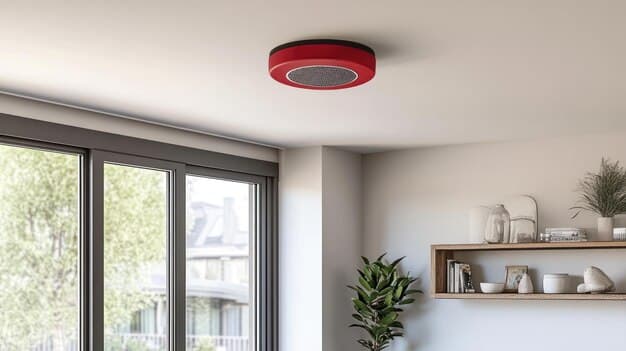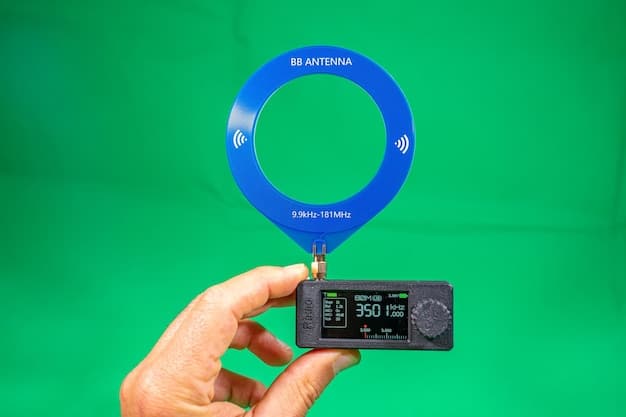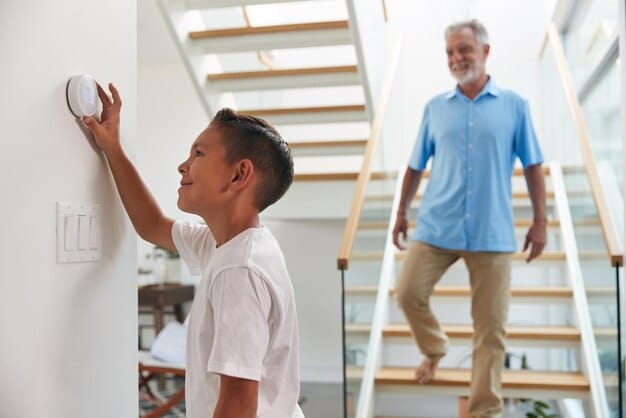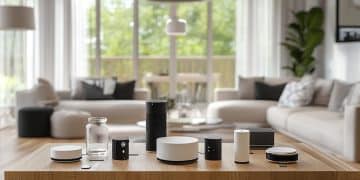Smart Home Safety: Fire and Carbon Monoxide Protection Devices for US Families

Ensure your US family’s safety from fire and carbon monoxide with smart home devices like smoke detectors, carbon monoxide detectors, and smart home systems that provide alerts and automation for quick response.
Protecting your family from fire and carbon monoxide is a top priority. With the rise of smart home technology, smart home safety devices offer advanced features and connectivity to enhance your home’s security in the US.
Understanding the Risks: Fire and Carbon Monoxide
Fire and carbon monoxide (CO) are significant threats to home safety. Understanding these risks is the first step in protecting your family. Fires can spread rapidly, and carbon monoxide is an odorless, invisible gas that can be deadly.
The Dangers of Fire
Fires can start from various sources, including cooking accidents, electrical malfunctions, and heating equipment. Smoke inhalation is a major cause of injury and death in fires, making early detection crucial.
The Silent Threat: Carbon Monoxide
Carbon monoxide is produced by incomplete combustion in appliances such as furnaces, stoves, and generators. Because it’s undetectable by human senses, CO can quickly build up to dangerous levels without anyone knowing.

Smart home safety devices are designed to mitigate these risks by providing early warnings and enabling prompt responses.
Protecting your family involves understanding the risks posed by fire and carbon monoxide. Awareness and proactive measures are essential.
Essential Smart Home Safety Devices
Equipping your home with the right smart safety devices is essential for comprehensive protection. Here are some key devices to consider for your US home.
Smart Smoke Detectors
Smart smoke detectors offer advanced features compared to traditional detectors. They can send alerts to your smartphone, even when you’re not home, and often include interconnected systems that sound an alarm throughout the house.
Smart Carbon Monoxide Detectors
These detectors continuously monitor CO levels and send alerts to your smartphone if dangerous levels are detected. Some models also display the current CO level, providing additional insight into your home’s air quality.
Smart Home Security Systems
Many smart home security systems integrate fire and CO detection, providing a unified platform for monitoring and alerting. These systems can also include professional monitoring services that can dispatch emergency responders in case of an alarm.
- Interconnected Alarms: Ensure that all smoke and CO detectors are interconnected, so if one detects a problem, all alarms sound.
- Mobile Alerts: Choose devices that send real-time alerts to your smartphone, allowing you to take action quickly.
- Professional Monitoring: Consider a system with professional monitoring for 24/7 protection and emergency response.
Investing in these smart devices can significantly enhance your home’s safety and provide peace of mind.
Smart safety devices are a crucial layer of protection against fire and carbon monoxide, providing early warnings and enabling quick action.
Benefits of Smart Home Safety Technology
Smart home safety technology offers numerous benefits that enhance traditional safety measures. These advantages can make a significant difference in protecting your family and property.
Remote Monitoring and Alerts
One of the most significant benefits is the ability to monitor your home remotely. Smart devices send alerts to your smartphone, allowing you to respond quickly to potential threats, even when you’re away.
Enhanced Detection Capabilities
Smart detectors often have advanced sensors that can detect smoke and CO more accurately than traditional devices. This reduces the risk of false alarms while ensuring early detection of real threats.
Integration with Smart Home Ecosystems
Smart safety devices can integrate with other smart home devices, such as smart lighting and smart locks, to create automated safety responses. For example, in the event of a fire alarm, smart lights can turn on to guide occupants to safety, and smart locks can unlock doors for easy evacuation.

The integration of smart technology with home safety provides a more comprehensive and responsive safety net.
Smart home safety technology offers remote monitoring, enhanced detection, and seamless integration with other devices, significantly improving your home’s safety.
Installation and Maintenance Tips
Proper installation and regular maintenance are crucial for ensuring that your smart home safety devices function effectively. Here are some tips to keep your system in optimal condition.
Proper Placement of Detectors
Install smoke detectors on every level of your home, inside and outside bedrooms, and near cooking areas. CO detectors should be placed near sleeping areas and in rooms with fuel-burning appliances.
Regular Testing and Battery Replacement
Test your smoke and CO detectors monthly to ensure they are working correctly. Replace batteries at least once a year, or as recommended by the manufacturer. Many smart detectors will send a notification when the battery is low.
Keeping Devices Clean
Dust and debris can interfere with the sensors in smoke and CO detectors. Clean your devices regularly with a soft brush or vacuum cleaner to ensure accurate detection.
- Follow Manufacturer Instructions: Always adhere to the manufacturer’s guidelines for installation and maintenance.
- Check Expiration Dates: Smoke and CO detectors have expiration dates. Replace them as recommended, typically every 5-10 years.
- Professional Inspection: Consider having a professional inspect your home’s safety devices annually to ensure they are functioning correctly.
Correct installation and consistent maintenance are essential for maintaining the dependability of your smart home safety devices.
To maintain the effectiveness of your smart home safety system, prioritize appropriate placement, regular testing, battery replacements, and routine cleaning.
Choosing the Right Devices for Your Home
Selecting the right smart home safety devices depends on your specific needs and preferences. Consider these factors to make an informed decision.
Evaluate Your Home’s Needs
Assess the size and layout of your home to determine the number of detectors needed. Consider any specific risks, such as the presence of older appliances or fireplaces, that may require additional protection.
Consider Compatibility
Ensure that the smart safety devices you choose are compatible with your existing smart home ecosystem. This will allow for seamless integration and automation.
Read Reviews and Compare Features
Research different brands and models of smart detectors to compare features, reliability, and customer reviews. Look for devices with high ratings and positive feedback.
Selecting the appropriate devices is a personalized decision that should take into account your home’s layout and any potential threats.
When choosing smart home safety devices, assess your home’s needs, ensure compatibility with existing systems, and read reviews to make an informed decision.
Integrating Smart Safety with Your Smart Home Ecosystem
Integrating your smart safety devices with your broader smart home ecosystem can enhance their functionality and provide a more seamless user experience. Here’s how to integrate them effectively.
Connecting to Smart Hubs
Many smart smoke and CO detectors can connect to smart hubs such as Amazon Alexa, Google Home, or Apple HomeKit. This allows you to control and monitor your devices from a central app and create automated routines.
Creating Automated Routines
Use your smart hub to create automated routines that enhance safety. For example, you can create a routine that turns on smart lights and unlocks smart locks when a smoke alarm is triggered.
Utilizing Voice Control
With voice control, you can easily check the status of your detectors and receive alerts through your smart speaker. This provides an additional layer of convenience and accessibility.
Integrating smart safety devices with the smart home ecosystem is a simple approach to improve their capabilities and provide for a more user-friendly experience.
By linking to smart hubs, configuring automated routines, and using voice control, you may integrate smart safety devices seamlessly into your smart home ecosystem for increased safety.
| Key Point | Brief Description |
|---|---|
| 🚨 Smart Smoke Detectors | Send alerts to your smartphone and interconnect with other devices for whole-house alarm. |
| 🧪 Smart CO Detectors | Monitor carbon monoxide levels and alert you via smartphone to prevent poisoning. |
| 💡 Integration | Connect safety devices with smart hubs like Alexa or Google Home for automated routines. |
| 🛠️ Maintenance | Regularly test devices, replace batteries, and keep sensors clean for optimal performance. |
Frequently Asked Questions (FAQ)
▼
Smart smoke detectors offer mobile alerts, interconnection with other smart devices, and more accurate detection compared to traditional detectors, providing enhanced safety and peace of mind.
▼
It’s recommended to test your smart carbon monoxide detectors monthly to ensure they are functioning correctly. Regular testing helps identify any potential issues and ensures early detection of CO.
▼
Yes, many smart safety devices are designed to integrate with popular smart home systems like Amazon Alexa, Google Home, and Apple HomeKit, allowing for seamless control and automation.
▼
Install smoke detectors on every level of your home, inside and outside bedrooms, and near cooking areas. Place CO detectors near sleeping areas and in rooms with fuel-burning appliances.
▼
If you receive an alert while away, first verify the alert’s legitimacy through a neighbor or local authorities. If confirmed, contact emergency services immediately and provide them with the necessary details.
Conclusion
Investing in smart home safety devices significantly enhances your family’s protection against fire and carbon monoxide. By understanding the risks, choosing the right devices, and integrating them effectively into your smart home ecosystem, you can create a safer and more secure environment for your loved ones in the US.





